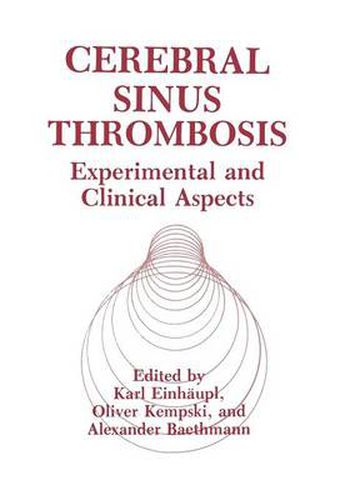Readings Newsletter
Become a Readings Member to make your shopping experience even easier.
Sign in or sign up for free!
You’re not far away from qualifying for FREE standard shipping within Australia
You’ve qualified for FREE standard shipping within Australia
The cart is loading…






This title is printed to order. This book may have been self-published. If so, we cannot guarantee the quality of the content. In the main most books will have gone through the editing process however some may not. We therefore suggest that you be aware of this before ordering this book. If in doubt check either the author or publisher’s details as we are unable to accept any returns unless they are faulty. Please contact us if you have any questions.
Contrary to the neurological manifestations of arterial cerebral blood flow disturbances, respective conditions resulting fram obstruction of the cerebro-venous system are far less well understood. Hence, cerebral sinus vein thrombosis (CSVT) ranks prominently among the group of neglected diseases of the brain. This might be attributable (a) to the diagnostic difficulties of the disorder and (b) to the fact that CSVT is associated with a host of heterogeneous neurological symptoms which often are not specific for the underlying venous flow disorder. Another complicating aspect is that CSVT is a consequence of other diseases as disparate as focal infection, trauma, neoplasia, or a thrombosis disposition caused by oral contraceptive use. Although progress has been made in establishing the correct diagnosis of the syndrome, many problems remain as the discussions contained within this volume vividly demonstrate. The same is true for the present understanding of the pathophysiological basis of the disease, eg, concerning the cerebro-venous circulation, the hemodynamic and neuropathological consequences in particular. Part of these deficits may be attributed to a scarcity of solid experimental data due to the limited availability of animal models. However, relevant experimental models are required for an in-depth analysis of the pathophysiological mechanisms, eg, causing brain tissue damage in relationship with the topographical distribution of the venous flow obstruction and, most importantly, for the testing of specific methods of treatment.
$9.00 standard shipping within Australia
FREE standard shipping within Australia for orders over $100.00
Express & International shipping calculated at checkout
This title is printed to order. This book may have been self-published. If so, we cannot guarantee the quality of the content. In the main most books will have gone through the editing process however some may not. We therefore suggest that you be aware of this before ordering this book. If in doubt check either the author or publisher’s details as we are unable to accept any returns unless they are faulty. Please contact us if you have any questions.
Contrary to the neurological manifestations of arterial cerebral blood flow disturbances, respective conditions resulting fram obstruction of the cerebro-venous system are far less well understood. Hence, cerebral sinus vein thrombosis (CSVT) ranks prominently among the group of neglected diseases of the brain. This might be attributable (a) to the diagnostic difficulties of the disorder and (b) to the fact that CSVT is associated with a host of heterogeneous neurological symptoms which often are not specific for the underlying venous flow disorder. Another complicating aspect is that CSVT is a consequence of other diseases as disparate as focal infection, trauma, neoplasia, or a thrombosis disposition caused by oral contraceptive use. Although progress has been made in establishing the correct diagnosis of the syndrome, many problems remain as the discussions contained within this volume vividly demonstrate. The same is true for the present understanding of the pathophysiological basis of the disease, eg, concerning the cerebro-venous circulation, the hemodynamic and neuropathological consequences in particular. Part of these deficits may be attributed to a scarcity of solid experimental data due to the limited availability of animal models. However, relevant experimental models are required for an in-depth analysis of the pathophysiological mechanisms, eg, causing brain tissue damage in relationship with the topographical distribution of the venous flow obstruction and, most importantly, for the testing of specific methods of treatment.